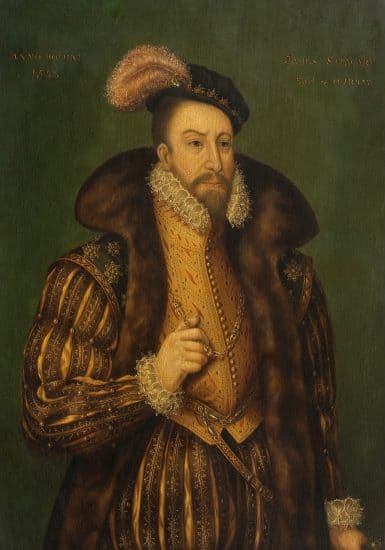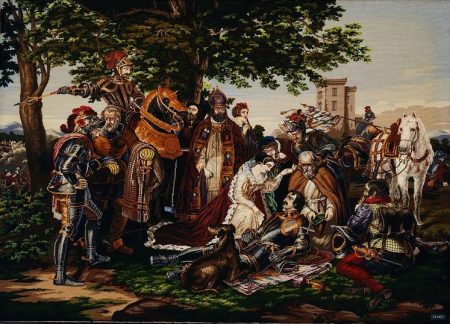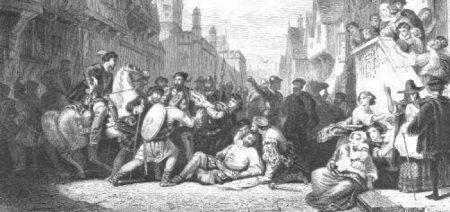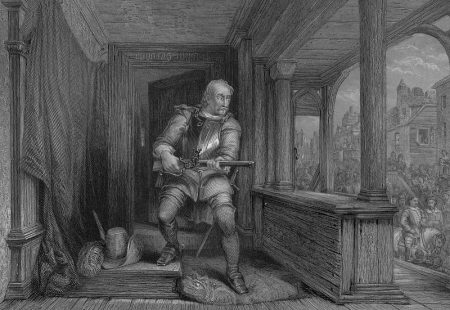Editor’s Note: This post on Tales of Mighty Men comes to us from Stephen Huffman

The young queen gazed out between the bars of her castle window as a rowboat made its way across “Bonnie Loch Leven.” As the boat drew near, the imprisoned monarch’s heart sank as she recognized the man she hated more than any other.
Mary Stuart, Queen of Scots, primed and loaded all the weapons in the arsenal of a beautiful queen still in her early twenties. First, she complained about the treatment of her royal person by the rebellious Protestant nobles. Then she began to interrogate her visitor, mixing her questions with tears and threats, smiles and frowns. Her visitor remained unmoved and responded with the tactic for which she was least prepared—silence. Gradually, her front came down as her questions focused on one pressing theme: What would be her fate at the hands of the Protestant nobility? Still, the only response was dreadful silence.
Driven to despair, the queen implored her visitor to speak. Seeing that the queen had exhausted her arsenal, the grave visitor began. Slowly and methodically, with the precision of a prosecuting attorney sure of his case, he unfolded Mary’s crimes over the past two years. One by one, he recounted her immoral affairs, including her adultery with her Italian secretary, David Rizzio, which had ended with the murder of Rizzio by Mary’s husband, Lord Darnley. These recitals moved Mary little, but as the next phase of the plot unfolded, Mary realized in horror how much the man standing before her actually knew.

In the aftermath of Rizzio’s murder, Mary had acquired another paramour, the Earl of Bothwell, with whom she had plotted to kill Darnley, her husband. After the deed had been accomplished, Mary had married Bothwell. In recounting the story, Mary’s visitor had revealed enough information to let her know that he knew the contents of incriminating letters to Bothwell, which revealed her treasonable plots, murderous schemes, and adulterous affections. Advising her to recommend herself to the mercy of God, her visitor left her for the night to speculate about her fate.
The queen had been awed into submission. The next morning, she agreed to resign the throne and pass it to her infant son. As a final act of royal prerogative, she begged her visitor, “the only man in Scotland whom every other man could trust,” to accept the regency during her son’s childhood. Thus, James Stewart, the Earl of Moray became the Regent of Scotland. To distinguish him from the many with his same name, we will call him by his title “Moray.”
Historians have ranked the Earl of Moray with Admiral Coligny of France and William of Orange as one of the three greatest statesmen of the Reformation. Born in 1531, Moray was an illegitimate son of James V, and it was this alone that prevented him from becoming king. A dispensation from the Pope had allowed him, at the age of 7, to be Prior of St. Andrews, an honorary post that providentially had placed him at the heart of the Reformation in Scotland. In 1555, when Moray was 24, he attended the preaching of John Knox and was converted. In 1556, he joined with other Protestant nobles in requesting John Knox to return to Scotland, but as yet, he had not openly declared for the Reformed cause.

To understand the importance of Scotland, and especially the unique role played by Moray, we must first outline the Catholic and Reformed strategies in 1559. Rome hoped to exert pressure on England by the return of Scotland to the Roman fold. Reformed Christians hoped that Scotland would remain firm in the Reformed cause. In 1559, John Knox returned to Scotland, settling in Perth, which became a Reformed city overnight. Mary of Guise advanced on Perth, but promised Knox he would be allowed to go in peace and that the city would not be disturbed. No sooner had he left the town than she occupied it with her French mercenaries. This breach of faith induced Moray to declare for the Reformed faith and join the “Congregation.”
From then on, Moray took the lead in the “Wars of the Congregation.” From Perth, the “Congregation” marched toward Edinburgh, purging the cities of St. Andrews, Stirling, and Linlithgow of idolatry. When Mary of Guise received reinforcements from France, Moray conducted a heroic delaying action. For twenty days, he led his small army of 600 men against 4,000 Frenchmen, losing only 1 man to every 4 the French lost. The campaign ended when Mary of Guise died and the French army was withdrawn.
Moray was made Regent for a brief period until Mary Stuart returned, during which time many advances were made toward the cause of the Reformation. Popery and idolatry were abolished, and the laws of the Bible were established as the law of the land. When Mary, his half sister, came to throne, she inherited a land that was thoroughly Reformed.
During the early years of Mary’s reign, Moray mistakenly believed that the long-range interests of the Reformation would be best served by tolerating the queen’s idolatries for a time while cultivating English support. This policy drew the censure of Knox, and Moray lost the trust of the reformers for a time. Gradually, however, Moray came to see that Knox was right and he needed to take a more resolute approach to the purging of idolatry from the land. In 1567, Moray visited France. Catharine de Medici reported that he was “as thick as thieves with Coligny and Condé.” Meanwhile, Mary was committing the crimes already related.
During the next three years, Moray was finally able to establish the Reformation in Scotland. When Mary escaped from Loch Leven, Moray decisively defeated her forces at the battle of Langside. Mary fled to England, where she was imprisoned.

Moray was the model of a Christian statesman. He recognized that the purpose of civil government was to enforce God’s law and to put evildoers in terror. Naturally, he was hated by the enemies of righteousness. He survived at least nine separate attempts and plots. John Knox records that Mary “hated his upright dealing, and the image of God which evidently did appear in him.”
Moray affirmed two of the truths that would shape the next 100 years of Scottish history. First, he recognized the independent authority and discipline of the Kirk (church) under the headship of Christ. Second, by participating in the deposing of Mary, he set a precedent for holding monarchs accountable to law.
Moray advanced the Reformation in other ways. By commissioning David Peebles to harmonize the Psalms in four parts, he contributed much to the rich psalm-singing tradition of Scotland. He also set an example of family worship. Buchanan records that “his house was like a holy temple; after meals he caused a chapter of the Bible to be read, and asked the opinions of such learned men as were present upon it, not out of vain curiosity, but from a desire to learn, and to reduce to practice what it contained.” Faithful to his wife, Agnes Keith, he set an example of loyalty in marriage rare even among Protestant nobility.
By 1570, it was the unanimous opinion of the Pope, Catharine de Medici, the Duke of Guise, the Cardinal of Lorraine, and various political rivals that Moray must die. At the age of 39, on January 23, 1570, Moray was shot by an assassin as he passed through Linlithgow, dying a few hours later.

The news of his death stunned Knox, who never fully recovered from the blow. Even Moray’s enemies praised him, and Elizabeth I exclaimed with tears that she had lost the best and most useful friend she had in all the world. At the Kirk of St. Giles, where Moray is buried, Knox preached the funeral sermon from the Geneva Bible: “The dead which die in the Lord, are fully blessed. Even so saith the Spirit: for they rest from their labors, and their works follow them.”
Never again would Popery pose a threat in Scotland. Providence had used an illegitimate son of a Papist king to advance the Kingdom of Christ. Spottiswoode’s History called him, “A man truly good, and worthy to be ranked among the best governors that this kingdom hath enjoyed, and therefore to this day honored with the title of “The Good Regent.”

Bibliography
The Reformation in Scotland by John Knox
The Scots Worthies by John Howie
James Stewart, Earl of Moray by Maurice Lee, Jr




